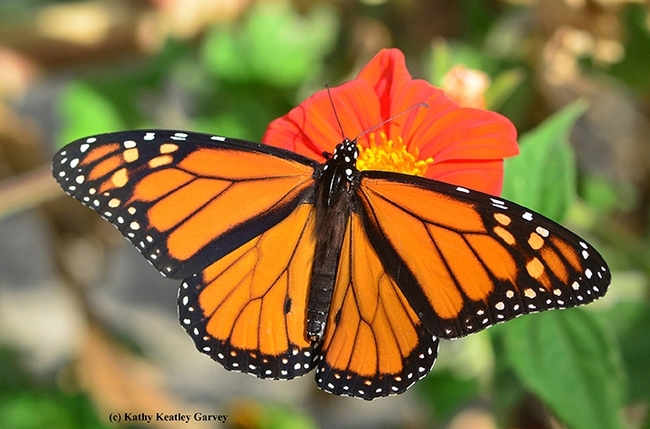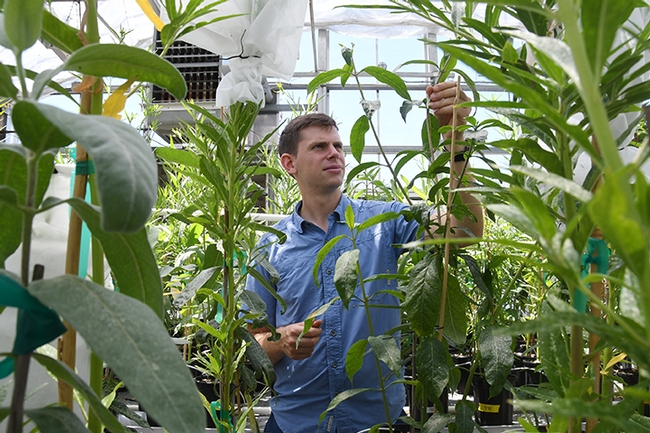
The paper, “Two Centuries of Monarch Butterfly Collections Reveal Contrasting Effects of Range Expansion and Migration Loss on Wing Traits,” appears this week in the Proceedings of the National Academy of Sciences.
The researchers:
- Lead author Micah Freedman, a former UC Davis doctoral candidate in population biology and now a postdoctoral fellow at the University of Chicago.
- Emeritus professor Hugh Dingle of the UC Davis Department of Entomology and Nematology, a noted authority on migrant animal behavior
- Sharon Strauss, professor, Center for Population Biology and the Department of Evolution and Ecology
- Santiago Ramirez, associate professor, Center for Population Biology and the Department of Evolution and Ecology
What they did:
"We measured the wings of 6,000 museum specimens of monarch butterflies collected from 1856 to the present, as well as contemporary wild-caught monarchs from around the world,” Freedman said. "The major implications of the research,” Freedman said, “are that it shows (1) loss of migration can affect the evolution of monarch butterflies over contemporary time scales--dozens to hundreds of years; and (2) monarchs with large forewings are better-suited for long distance movement, and this likely contributed to their global expansion over the past 200 years.”
Their research documents how migration-associated traits may be favored during range expansion but disfavored when species cease seasonal migration. “Furthermore, it highlights the value of museum collections by combining historical specimens with experimental rearing to demonstrate contemporary evolution of migration-associated traits in natural monarch populations,” Freedman said.
Freedman worked closely with Dingle, a UC Davis entomology professor from 1982 to 2002 who achieved emeritus status in 2003. Dingle authored two editions of Migration: The Biology of Life on the Move (Oxford University Press), is a fellow of the American Association for the Advancement of Science, and a past president of the Animal Behavior Society. His research has taken him throughout the world, from the United States to the UK, Kenya, Thailand, Panama, Germany and Australia. National Geographic featured him in its cover story on “Great Migrations” in November 2010. LiveScience interviewed him for its November 2010 piece on“Why Do Animals Migrate?”

The researchers analyzed monarch specimen collections from nearly two dozen museums, including the Bohart Museum of Entomology, University of California, Davis.
The Bohart Museum, located in Room 1124 of the Academic Surge Building on Crocker Lane, UC Davis campus, houses a global collection of nearly 8 million insect specimens. Directed by Lynn Kimsey, professor of entomology and a former chair of the UC Davis Department of Entomology and Nematology, the Bohart is geared toward "Understanding, documenting and communicating terrestrial arthropod diversity," which appears on its logo; see website. (Note that the Bohart Museum is temporarily closed due to the COVID-19 pandemic precautions.)
Said Dingle: “At a time when museum collections are under pressure from a scarcity of funding, the results also show just how valuable such collections can be to evolutionary research and to the understanding of ongoing biological processes in the face of anthropogenic change.”
His comments bear repeating:
That bears repeating: “At a time when museum collections are under pressure from a scarcity of funding, the results also show just how valuable such collections can be to evolutionary research and to the understanding of ongoing biological processes in the face of anthropogenic change.”
Attached Images:

UC Davis emeritus professor Hugh Dingle, wearing a Bohart Museum t-shirt, and then doctoral student Micah Freedman, did monarch research on Guam.

Former UC Davis doctoral student Micah Freedman tending his milkweed in a UC Davis greenhouse, where he reared monarchs for research. (Photo by Kathy Keatley Garvey)